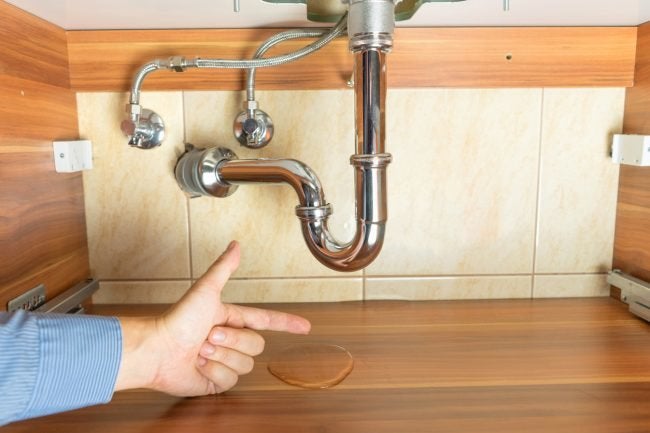Detecting Concealed Water Line Leaks: Six Clever Hacks
Detecting Concealed Water Line Leaks: Six Clever Hacks
Blog Article
Just about everyone is bound to have their unique ideas about Finding hidden leaks.

Early discovery of leaking water lines can alleviate a possible disaster. Some small water leakages might not be visible.
1. Check Out the Water Meter
Every house has a water meter. Inspecting it is a proven manner in which helps you find leakages. For beginners, turn off all the water sources. Make certain no one will flush, make use of the faucet, shower, run the cleaning equipment or dishwashing machine. From there, most likely to the meter and watch if it will alter. Considering that no one is using it, there must be no movements. If it moves, that shows a fast-moving leakage. Furthermore, if you spot no changes, wait a hr or 2 and check back once again. This suggests you might have a sluggish leak that might even be underground.
2. Inspect Water Usage
If you detect abrupt modifications, despite your intake being the exact same, it means that you have leakages in your plumbing system. An unexpected spike in your costs suggests a fast-moving leak.
A stable rise every month, even with the very same routines, shows you have a slow leak that's also slowly rising. Call a plumber to completely examine your building, particularly if you really feel a warm location on your floor with piping below.
3. Do a Food Coloring Examination
30% comes from bathrooms when it comes to water consumption. Examination to see if they are running properly. Decrease flecks of food color in the storage tank and wait 10 minutes. There's a leakage between the container as well as dish if the color in some way infiltrates your bowl during that time without flushing.
4. Asses Exterior Lines
Do not forget to inspect your outdoor water lines as well. Examination spigots by connecting a yard hose. Must water permeate out of the connection, you have a loose rubber gasket. Replace this as well as make sure all connections are tight. If you have actually obtained a sprinkler system, it will certainly aid get it expertly examined as well as maintained every year. One little leak can lose lots of water and surge your water costs.
5. Examine as well as Assess the Situation
Property owners need to make it a habit to inspect under the sink counters as well as also inside cabinets for any bad odor or mold growth. These two warnings show a leakage so prompt attention is needed. Doing regular examinations, even bi-annually, can save you from a significant problem.
Check for stainings and also damaging as a lot of appliances and also pipelines have a life expectancy. If you suspect dripping water lines in your plumbing system, do not wait for it to intensify.
Early detection of leaking water lines can minimize a possible catastrophe. Some small water leaks might not be visible. Checking it is a proven method that assists you discover leakages. One small leak can waste lots of water and spike your water costs.
If you presume leaking water lines in your plumbing system, do not wait for it to intensify.
How to Know If Your Home Has a Hidden Leak
Water Meter Reveals Inexplicable Water Usage
If you’d like to test whether or not there’s a leak somewhere in your home, you can do this using your water meter. Here is how to conduct the test:
Don’t use any water in your home for at least 30 minutes; this also means not turning on faucets or water-using appliances.
Go outside, and check your water meter for activity.
If your water meter shows that there was activity, even though no one was using any water, this proves that there is a leak in your home.Visible Mold or Mildew Growth
Leaks behind walls create moist, dark environments that allow mold and mildew to grow and thrive. Eventually, you might see mold growth forming on the wall closest to a hidden leak.
If mold is growing in an area that receives a high amount of moisture, such as a bathroom, it may simply be an indication that better ventilation is needed. However, if you see mold growth on a wall or the ceiling in an area where you would not expect, you probably have a hidden leak.
Musty, Mildew Odor
Sometimes you might not be able to see the mold or mildew that is growing as a result of a leak. However, the smell can give the problem away just as easily. If you catch a whiff of something musty, there’s a good chance that old water is collecting somewhere in your home that you can’t see.
Stained/Warped Walls, Ceilings, or Floors
When your home soaks up water, a variety of red flags can become visible, including ceiling stains, bubbling drywall, warped walls, and sagging floors. While these issues can be caused by excess humidity, they can also be signs that a pipe or plumbing connection has started leaking behind your walls.
Inexplicably High Water Bill
After a while, you get a general sense for what your water bill should be. If you own a pool or sprinkler system, your bill will tend to be higher during summer. However, if you receive a water bill that seems especially high, and you can’t figure out what caused it, then you may have a hidden leak somewhere that’s increasing your bill.
https://www.plumbingjoint.com/blog/2019/july/how-to-know-if-your-home-has-a-hidden-leak/

As an avid person who reads about Detecting hidden plumbing leaks, I think sharing that post was really useful. Liked our piece of writing? Please share it. Let other people check it out. I take joy in reading our article about Detecting hidden plumbing leaks.
Emergency plumber? One call away. Report this page